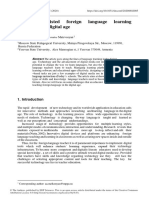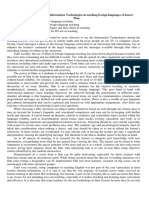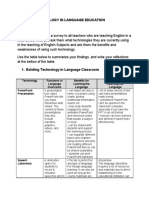372.881.111.
USING MULTIMEDIA AND LEARNING PLATFORMS IN EFL
Gulnara Akhmetova
Gulnarkz1987@mail.ru
L.N.Gumilyov Eurasian National University,
Nur-Sultan, Kazakhstan
Abstract. The present research paper discusses the role of multimedia and
learning platforms in EFL lessons. The authors describe the ways how modern
multimedia tools and learning platforms are employed effectively in EFL classes in
secondary schools. Moreover, the paper focuses on the advantages of using
multimedia in EFL, as well as practical experience of using some modern learning
platforms and tools.
Key words: multimedia, learning platforms, informatization, white board, EduPage.
Multimedia every day more and mоrе pеnеtrаtе intо vаriоus sphеrеs оf
educational activity. This is facilitatеd by both еxtеrnal factors associated with thе
widespread Infоrmаtizаtiоn of society and the need for appropriate training of
schoolchildren, and internal factors associated with the spread in secondary schools
of modern computer technology and software, the adoption of state and international
programs of Infоrmаtizаtiоn of еduсаtiоn, the emergence of the necessary experience
of Informatization in an increasing number of school teachers. In most cases, the use
of multimedia has a positive impact on the intensification of teachers' work, as well
as on the effectiveness of teaching students.
Multimedia is the integration of the specialized hardware and software, allows
at a qualitatively new level to accept and process a variety of information: text,
image, sound, animation, television. The main objectives of multimedia are the
transition from knowledge pedagogy to competence, the development of creative
abilities of students through interactivity, which opens up huge cognitive abilities to
students. The advantages of training using multimedia: reducing the unproductive
costs of live teacher work; the possibility of free choice of their own trajectory of
learning; increasing efficiency and objectivity of monitoring and evaluation of
learning outcomes; continuous communication in the relationship "student – teacher";
individualization of learning activities; increasing motivation for learning;
development of younger students productive, creative functions of thinking,
intellectual abilities, the formation of an operational style of thinking [1].
Nowadays, technology offers big range of different tools that teachers can
employ in the foreign language classroom to enhance students’ acquisition and
improve concentration. Interactive White Boards are widespread and almost all
of the schools equip the language classroom with them. It is a precious source
for the teachers that enable multimedia application in the teaching. Power Point
�presentations is another tool that stimulates thinking and it is very often used in the
language classroom.
The most important information technology tool is a computer. A computer has
several advantages: it combines audio-video information, text information, the ability
to record your own voice and further self-correction of pronunciation. Computer
technologies can be used at all stages of training: upon presentation of new material,
consolidation, repetition, control of knowledge and skills, in extracurricular work [2].
Using computer tools, students:
1) enter new text information using the keyboard or use already prepared materials,
scanning them or entering them into new files from diskettes;
2) get access to extensive information in their native and foreign languages, thanks to
reference and information systems and networks, using machine translation systems
if necessary;
3) prepare, edit and improve written works with the help of programs such as "text
editor", spellers and document templates;
4) work with interactive text generation programs and automatic text processing
systems (abstracting annotations, etc.);
5) systematize and Supplement the text information with tables, graphs, diagrams and
figures.
It should be noted that the introduction of multimedia in the process of learning
a foreign language culture will be successful only if the level of information culture
of the teacher himself meets modern requirements. Only by mastering computer
science as a science can you change the whole approach to the organization of the
process of training and education. Next, you need to help the students understand that
the word “computer” is associated not only with the word “game”. Explaining the
diversity of computer capabilities in the study of foreign languages, the formation of
the "educational vector" of its use contributes to the improvement of cognitive
activity and, accordingly, the quality of students' knowledge. Through the use of
information technology increases the information content of the material being
studied, which increases the interest in the subject "foreign language" [3].
Requirements for a foreign language teacher in the use of computer technology
are much higher than the requirements for teachers of other subject disciplines, since
language teaching software includes a very wide range of software and teaching
materials focused on different levels, stages, aspects and learning profiles. A modern
teacher should be able to use computer technologies in all their diversity at the
modern methodological level. The use of training and educational programs is the
most accessible way to use a computer both in class and during school hours.
Consider an example of organizing the verification of homework using
multimedia in the classroom in elementary school. With the help of control, the
degree of assimilation of the material can be established: memorization of what was
read in the textbook, heard in the lesson, learned during independent work, at the
practical lesson, and reproduction of knowledge during testing. To solve the didactic
task of the homework verification phase, we suggest the following types of
multimedia should be used [4]:
a) multimedia:
� - presentation-control - for organizing a self-test, mutual testing of homework
or tasks for primary consolidation, you can use the presentation-test, at the end
specify the criteria for evaluating work (Power Point);
- presentation-test with animation - contains the wording of the task and
response options, with the help of animation the correct answer is marked or incorrect
ones are discarded (Power Point);
- presentation-test with hyperlinks - contains the wording of the task and
response options, with the help of the hyperlink the transition to the slide with
information about the correctness of the choice of answer is organized. In the case of
a correct choice, a transition is made to the next question; if the answer is incorrect, a
return to the same question occurs (Power Point);
b) handouts:
- tests (Excel), (Word);
- cards (Word);
- crosswords (Excel);
- independent work (Word);
- control work (Word) [35, p. 23].
As a research object of this study EFL classes
To solve the didactic problem of this stage, teachers use:
a) multimedia:
- presentation-lecture - demonstration of slides containing illustrations, theses,
videos or sound to explain the new material, generalization, systematization (Power
Point), in this case, presentations are used to acquaint students with the object or
phenomenon, process;
- video clips of films;
- presentation-model - with the help of animation, a model of a process,
phenomenon, visual solution of the problem (Power Point) is created;
- slideshow - a demonstration of illustrations with a minimal amount of text,
with the imposition of music, with the installation of an automatic slide change,
sometimes with a cyclical repetition of slides (Power Point);
- Image - correction of photos, scanned images, coloring images (Photo Shop);
- collage - creating your own original rebuses, images (Photo Shop);
- video clip - based on photos, video and sound files; using effects and
transitions, creates a demo (Movie Maker);
b) computer technologies:
- charts (Excel);
- schemes (Excel);
- tables (Word).
This paper focused mainly on the principal technologies and tools that the ESL
teacher at “NURORDA” school lyceum employed. Let us consider an example of
organizing the consolidation and systematization of knowledge with the use of
multimedia by secondary school teachers of “NURORDA” school-lyceum.
According ESL teachers at the above mentioned school, systematization and
consolidation of the material are necessary for better memorization and accurate
structuring. At the end of the lesson, they review the material studied, highlighting
�the main points and their interrelationships. At the same time, teachers organize the
repetition of the material not only verbally, but also with a demonstration of the most
important visual aids on slides, as well as tests on a computer. To effect different
aims at the lesson teachers use various multimedia tools and educational platforms.
To motivate students on the one hand, and to show students’ achievements
demonstratively teachers use Class Dojo program showing students’ points on the
white board and commenting their evaluation and giving feedback.
ClassDojo is an educational technology company. It connects primary school
teachers, students and families through communication features, such as a feed for
photos and videos from the school day. It also enables teachers to note feedback on
students' skills and creates a portfolio for students, so that families can be aware of
school activities outside of meeting with teachers. ClassDojo allows students,
teachers and families to communicate. To use ClassDojo, teachers register for a free
account and create "classes" with their students. They can give students feedback for
various skills in class. These are customizable, and teachers can change the skills to
adapt to the needs of the class or of the school. Teachers have the option to post
pictures and videos onto their class's story, or to their school story. They can also
message with families, receiving 'read receipts' to know when their messages have
been read. Students do not need to download ClassDojo or create an account. If they
choose to, they get an access code from the teacher; after creating an account, the
students can customize their avatar, add photos and videos to their portfolio, and view
the 'Story' for each of their classes [5].
Families can also access ClassDojo when they are invited by their child's
teacher, and receive updates on what's happening in school, view their whole class's
story and see a timeline of their own child's experiences in the classroom through
pictures and videos.
One of the effective educational platforms applied at school system is
EduPage. Complete school system
EduPage is a cloud-based school management system that is fully integrated
with our world-leading scheduling program. A good school schedule is crucial for
most tasks, from entering the curriculum, tracking attendance, reserving classrooms,
setting homework assignments, to e-learning. Since the schedule changes daily, it is
vital to integrate it smoothly with other processes in the school. EduPage provides
many features, but you can only use some of them, but the true power of synergy is
shown when you start using more of EduPage's features, or ideally all of them.
Class register. The class log in EduPage reflects changes made to the schedule,
substitutions, and events. You simply select a lesson topic from your curriculum and
check student attendance. Boring administrative work will turn into a useful function.
Parents will be better informed about what their children have learned and whether
they are attending classes. Parents can help children with more complex topics [6].
To solve the didactic problem at ESL lessons English teachers use:
a) multimedia;
b) task presentations that contains the wording of the task; a step-by-step
solution of the task and answer (PowerPoint) are organized with the help of
animation;
� c) mobile class:
- group work - task - compose text for presentation slides (Power Point);
- select illustrative accompaniment for text (Photo Shop, Power Point);
d) Online Resourses: for group work.
Only in the case of high motivation of students to use multimedia resources, it
is possible to effectively targeted use of the educational potential of such resources. A
reasonable combination of the traditional form of organization of education and the
use of multimedia creates the prerequisites for the effective construction of the
learning process, since each of them has its own advantages and disadvantages.
In conclusion, multimedia and educational platforms are proved to be effective
educational tools due to the inherent qualities of interactivity, flexibility and
integration of different types of educational information, as well as the ability to take
into account the individual characteristics of students and to promote their
motivation. The use of multimedia allows students to work with educational materials
in different ways - the student decides how to study the materials, how to use
interactive features of informatization tools, and how to work together with their
classmates. Thus, students become active participants in the educational process.
BIBLIOGRAPHY
1. Simonenko V.D. General and professional pedagogy: a textbook for students of pedagogical
universities [Text]. - M .: Ventana-Graf, 2005. - 368 p.
2. Stolyarenko LD Pedagogical psychology [Text]. - Ed. 6th; erased - Rostov n / D: Phoenix,
2009. - 541 p.
3. Shiyan I.B., Adamsky A.I. Information technology in education [Text]. - M .: Evrika, 2003.-
144 p.
4. Morgun V.F. Integration and differentiation of education: personal and technological aspects
// School technologies [Text], 2012. - №3. - pp. 23-25.
5. Chaykowski, Kathleen (May 22, 2017). "How ClassDojo Built One of the Most Popular
Classroom Apps by Listening to Teachers". Forbes. Retrieved August 4, 2017.
6. www.edupage.org

























































